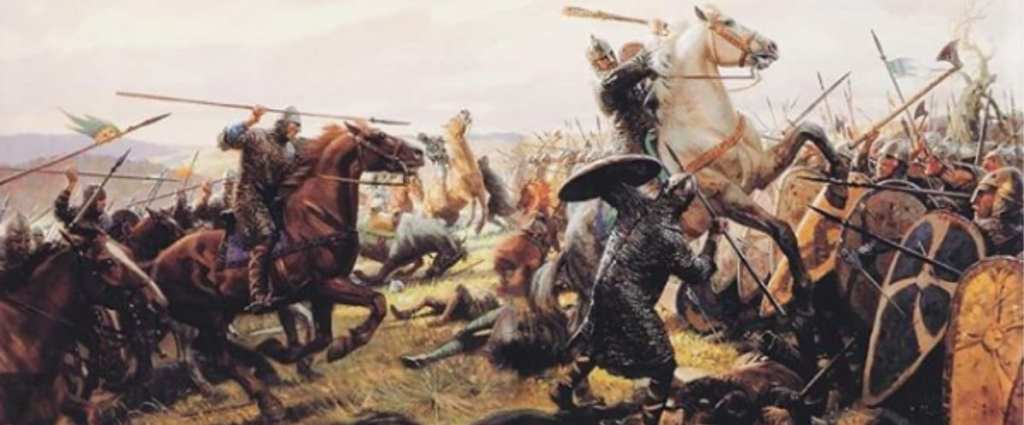File Under: Yes, History Can Be Both Fun And Interesting
Some might argue that, given the brutal, bloody way William the Conquerer ruled England, his brutal, stinking, bloody end was more than fitting.
William who-would-be-the-Conquerer was born around 1028 to the Duke of Normandy and a peasant girl. Officially a bastard, William still inherited his father’s titles at the age of 8. Normandy, though, found itself embroiled in a Civil War, and William’s childhood could not be described as idyllic, title or no.
Whether it came naturally to him or he learned the behavior of brutality, William embraced his legacy as he grew, punishing his defeated foes by chopping off their hands and feet in at least one instance.
In 1066, he won the bloody battle of Hastings and was crowned King of England on Christmas Day the same year.
Though he instituted some constitutional and social reforms and forged close ties with France while ending Viking influence in England, he’s mostly remembered for the way he treated the people that disagreed with and fought against him.
In 1069, he began a campaign known as “The Harrying of the North,” in which he put down rebellions by burning villages and slaughtering livestock (and sometimes people), leaving those who survived starving to the point of cannibalism.
William, however, grew fatter and fatter until an incident with his horse – an unexpected movement caused the saddle to puncture his intestines – eventually killed him.
https://www.instagram.com/p/BubxNq0hqTe/
It took 6 weeks, and while dying, the king supposedly confessed that he regretted at least some of his atrocities. According to Orderic Vitalis, a Benedictine monk and chronicler of English contemporary life, William spoke from his deathbed:
“I treated the native inhabitants of the kingdom with unreasonable severity, cruelly oppressed high and low, unjustly disinherited many, and caused the death of thousands by starvation and war, especially in Yorkshire …In mad fury I descended on the English of the north like a raging lion, and ordered that their homes and crops with all their equipment and furnishings should be burnt at once and their great flocks and herds of sheep and cattle slaughtered everywhere. So I chastised a great multitude of men and women with the lash of starvation and, alas! was the cruel murderer of many thousands, both young and old, of this fair people.”
He wanted his wealth to be given to churches and the poor upon his death, “so that what I amassed through evil deeds may be assigned to the holy uses of good men.”
https://www.instagram.com/p/B5DZTiBghF0/
A nice speech, though most historians and other experts – including author David Bates – doubt he ever said it.
“Orderic has William express regret for the terrible bloodshed as a part of his deathbed confession. Although the speech is, as far as we know, entirely Orderic’s invention and an idealized version of what he thought ought to have happened, what he was certainly saying is that he believed William made a good end, as also did Eadmer and William of Malmesbury.”
The fruits of his time on earth caught up with William, and when he finally died, the knights and other noblemen fled, leaving the King’s corpse vulnerable to the peasant class who despised him. Orderic paints a ghastly final scene.
“The lesser attendants, seeing that their superiors had absconded, seized the arms, vessels, clothing, linen, and all the royal furnishings, and hurried away leaving the king’s body almost naked on the floor of the house. …as if he had been a barbarian.”
Only one knight – Herluin – came back to ensure the king would be properly buried. He did this, according to Orderic, because of “his natural goodness,” and “procured at his own expense persons to embalm and carry the body; and hiring a hearse, he caused it to be carried to the port on the Seine; and embarking it on board a vessel, conducted it by water and land to Caen.”
View this post on InstagramA post shared by francesca archer?? 07842186502 (@the_tatton_collection) on
The 70 mile trip took some time, and by the time the body arrived in Caen, the bacteria in the king’s gut had leaked and begun to decompose the rest of his tissue at an alarming pace. The funeral was further delayed due to a fire in Caen, then again by a “mourner” who claimed he had been robbed of his land by the church. A legal meeting proceeded, and by the time the heckler was compensated and sent on his way, things had begun to get smelly.
The body had overheated and swollen to enormous proportions. He would not fit into his tomb, and while they were trying to decide what to do, his “swollen bowels burst, and an intolerable stench assailed the nostrils of the bystanders and the whole crowd.”
And everyone peaced out because, yeah. Gross.
William the Conquerer hasn’t exactly been undisturbed since – he’s been disinterred 3 times (by the Church, at the hands of the Calvinists, and again during the French Revolution). All that remains of his unlucky corpse is a thigh bone, which is marked by a slab of stone.
If ever there was a guy who was definitely haunting people, it’s William the Conquerer.
Not that I blame him, even if he was a big of a wanker in his prime.






